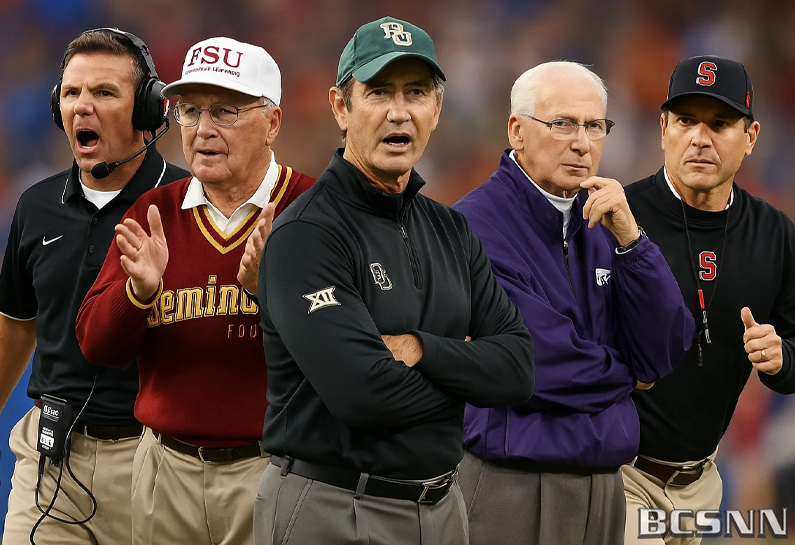(BCSNN) College football history is filled with dynasties and dominant programs, but some of the sport's most compelling stories come from coaches who engineered stunning turnarounds at historically struggling schools. These gridiron masterminds didn't just rack up wins — they rewrote the culture of losing programs and turned them into national contenders. Here's a look at five of the most remarkable rebuilders in college football history.
No. 1: Bill Snyder – Kansas State (1989–2005, 2009–2018)
Before Bill Snyder arrived in Manhattan, Kansas State was widely regarded as the worst program in Division I football. When Snyder took over in 1989, the Wildcats had just one winning season in the previous 45 years. By 1993, Snyder had guided them to their first bowl game in over a decade, and by the late 1990s, Kansas State was regularly ranked in the top 10, even reaching No. 1 briefly in 1998. Snyder’s tenure included two Big 12 championships and a legacy so enduring the stadium was renamed in his honor — while he was still coaching.
No. 2: Urban Meyer – Utah (2003–2004)
While Urban Meyer is best known for his national championships at Florida and Ohio State, his two-year stint at Utah was transformational. Before Meyer’s arrival, Utah was a middling Mountain West team. He installed a spread offense and recruited quarterback Alex Smith, who would go on to be a No. 1 NFL Draft pick. In 2004, Utah went undefeated (12–0), becoming the first non-BCS team to earn a BCS bowl berth, ultimately demolishing Pitt in the Fiesta Bowl. Meyer put Utah — and the Group of Five — on the national map.
No. 3: Bobby Bowden – Florida State (1976–2009)
When Bobby Bowden took over at Florida State in 1976, the Seminoles were one of the worst programs in the country, winning just four games in the previous three seasons combined. Bowden quickly transformed FSU into a national powerhouse through relentless recruiting, creative offensive schemes, and a fearless approach to scheduling. From 1987 to 2000, the Seminoles finished in the top five every season and won two national championships. Bowden turned Florida State into a perennial contender, creating one of college football's greatest dynasties from the ashes of obscurity.
No. 4: Art Briles – Baylor (2008–2015)
Despite a... "checkered ending" due to scandal, Art Briles’ on-field turnaround at Baylor was one of the most dramatic in recent memory. When he arrived in Waco, Baylor was a Big 12 doormat that hadn’t made a bowl game in over a decade. Briles implemented a high-octane offense and developed stars like Robert Griffin III, who won the Heisman in 2011. Under Briles, Baylor won two Big 12 titles and reached heights the program hadn’t seen in over a century. The Bears were legitimate national contenders by the time he was done.
No. 5: Jim Harbaugh – Stanford (2007–2010)
When Jim Harbaugh took over at Stanford, the Cardinal were 1–11 and irrelevant in the Pac-10. Harbaugh instilled toughness and confidence, leading Stanford to a major upset over No. 1 USC in just his first season. He recruited and developed quarterback Andrew Luck and, by 2010, had turned Stanford into a 12–1 powerhouse, culminating in an Orange Bowl victory. His success laid the foundation for a decade-long resurgence under David Shaw and helped redefine Stanford’s football identity.
Honorable Mention
Gary Patterson – TCU (2000–2021)
When Patterson became head coach, TCU was a mid-major without much recognition. Under his leadership, the Horned Frogs transitioned into the Big 12.
Mark Dantonio – Michigan State (2007–2019)
Dantonio inherited an underachieving program, and from 2010 to 2015, the Spartans won three conference titles and made the College Football Playoff in 2015.
David Cutcliffe – Duke (2008–2021)
Before Cutcliffe, Duke was widely regarded as a basketball school with a hopeless football program. He brought credibility and competitiveness back to Durham.
Howard Schnellenberger – Miami (FL) (1979–1983)
Schnellenberger took a floundering Miami program and laid the foundation for what would become a dynasty (and maybe our current player pay system too).
These coaches didn't just improve their teams — they shifted paradigms. Each inherited a program defined by losing and turned it into something formidable, in some cases reshaping college football landscapes entirely. Their legacies prove that with the right leadership, even a forgotten program can rise to the top.




























